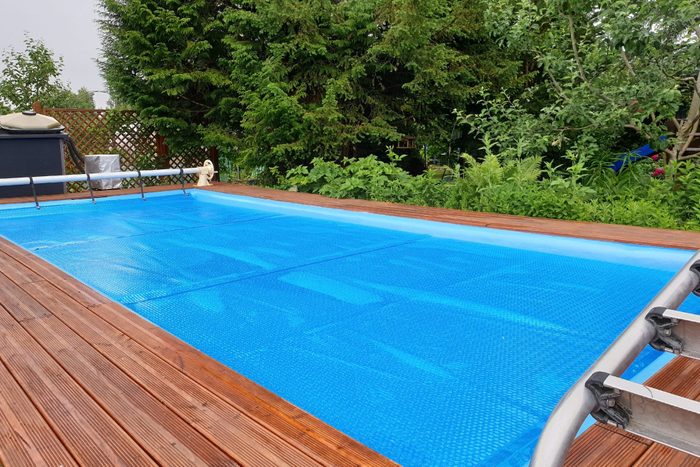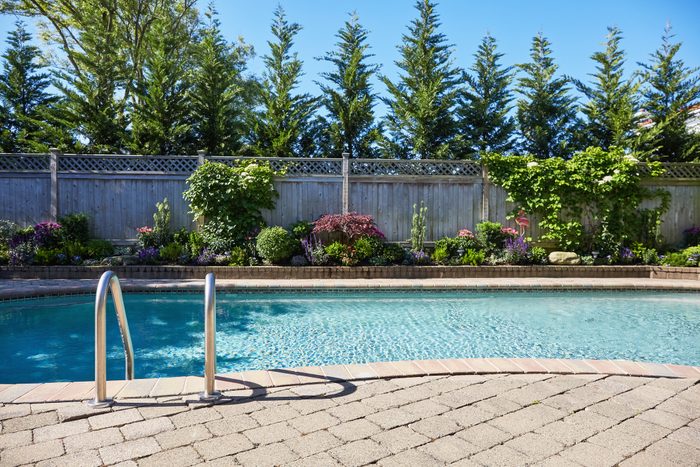The steps involved with prepping an in-ground pool for winter vary depending on where you live. Here's what you need to know.
A Guide To Winterizing an In-Ground Pool

Closing Down Your In-Ground Pool for the Season
When fall temperatures drop, signaling winter is on its way, it’s time to prepare your lawn, garden and outdoor entertainment areas for a long nap.
For in-ground pool owners, that means winterizing the pool — “putting it to bed,” so to speak — to protect it from months of disuse and harsh weather conditions. But depending on where you live, the steps may be different.
We asked a pool maintenance pro for his tips on winterizing an in-ground pool, whether you live in a mild climate or one with freezing temperatures.

Winterizing an In-Ground Pool in Freezing Climates
Even if you live where winter temperatures regularly drop below freezing, don’t expect to go ice-skating on your pool. But also don’t take freeze risk lightly, since ice and your pool do not mix. Jimmie Meece, brand president of America’s Swimming Pool Company, walks us through the steps for winterization a cold-climate pool. Next, learn how to build an ice rink on your own.
Also, check how to winterize your home and protect your possessions from the ravages of harsh winter.

Balance the Chemistry
“Before closing your pool, test and balance the water chemistry to ensure the pH, alkalinity and calcium hardness are at the recommended levels,” says Meece.
Once you’ve balanced the chemicals, your water should be OK until the spring. Still, it’s a good idea to test the water about once a month.

Clean the Pool
Use a leaf net, hand skimmer, pool vacuum or pool robot to remove debris and clean out smaller particles. It’s important to make the remaining water as clean as possible, because any debris can cause problems if it’s trapped over winter. And, chemical cleaners can only do so much.
If you have an automated in-ground pool cleaner, run it, then remove and store it for next season.

Lower the Water Level
Lowering the water level will prevent freeze damage to the pool pipes, the pump, the structure and pool surround, Meece says. Lower the water to just below the skimmer level. This gives the water that remains the space to expand in a freeze, and prevents cracks in pool walls.

Winterizing Equipment
“Turn off your pool pump and be sure to drain all pool equipment, including the pump, filter, heater and chlorinator,” says Meece.
Much like you’d winterize the plumbing in a cabin, pool plumbing needs to be completely free of water. That prevents freezing, which can cause extensive damage.

Blow the Lines
“Blow out and plug all pool lines to prevent water from freezing and causing damage,” says Meece. Even a small amount of standing water in the lines can stagnate or even freeze if temperatures drop low enough.
You can blow out your pool lines with an air compressor or a wet-rated, powerful shop vacuum if you have the right components.

Add the Pool Cover
Pools completely shut down in winter can be covered. Meece recommends a tight-fitting, durable pool cover to keep debris out of the pool and minimize evaporation. “In freezing climates,” he says, “covering is crucial to protect the pool from freeze damage and debris.”

Double-Check That Everything Is Turned Off
Once you’ve drained the water to just below the level of the skimmer and covered the pool, make sure all pumps are completely turned off. Running the pool once you’ve lowered water levels will likely damage the mechanics.

Winterizing an In-Ground Pool in Non-Freezing Climates
“In regions where the ground doesn’t freeze, the winterization process is less extensive,” says Meece. You can eliminate many of the steps because there’s no risk of things icing up.
Balance the chemistry
“Balance the pool’s water chemistry, similar to freezing climates,” says Meece. Because you presumably won’t be swimming for a while, this is a good time to shock the pool.
Clean the pool
As per the step above, give the pool a good cleaning before you shut or slow things down for the winter.
Add the cover
I live in a non-freezing climate and keep our in-ground pool uncovered during the winter, although we still run the pump a few hours a day and the pool robot about once a week. But every year, my husband talks about investing in a pool cover — and Meece recommends it.
“Using a pool cover is still advisable to keep out leaves and debris,” he says, “even though you may not need to worry about freeze-related damage.”

Swim Year-Round?
Meece says depending on your pool, location and the lengths you’re willing to go to, it’s possible to enjoy your pool year-round.
“To keep open year-round, you will still have to ensure that your pool pump and heater are running effectively and efficiently,” he says. “Ensure that you install a pool heater powerful enough to keep your pool warm during cold temperatures.”




















